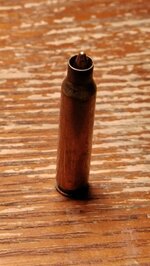- Messages
- 96
- Reactions
- 166
The discussion is probably on here, however I thought I'd share a reason to always crimp. Well, especially if you have calibers in bolt and semi auto. I picked this little up on the range. It was a malfunction, FTF. Fed through an AR and stubbed. Had this actually made it into the chamber, it would have provided a surprising outcome. Now it's a compressed load. The bullet is still in contact with neck, and the pressure upon firing would be great, (not in a good way)
The crimp isn't there to keep the bullet in, it's there to keep it from going in any further.
Obviously if one only has a bolt gun, neck tension would be adequate. But if you use the same ammo in both bolt and semi, better safe than have rapid disassembly of parts.

The crimp isn't there to keep the bullet in, it's there to keep it from going in any further.
Obviously if one only has a bolt gun, neck tension would be adequate. But if you use the same ammo in both bolt and semi, better safe than have rapid disassembly of parts.
















